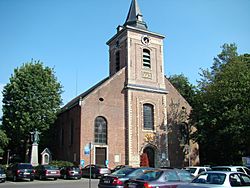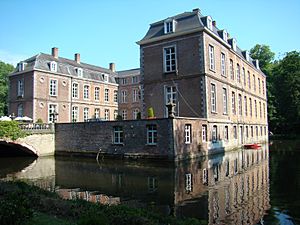Ingelmunster facts for kids
Quick facts for kids
Ingelmunster
|
|||
|---|---|---|---|

St-Amandus church besides the castle of Ingelmunster
|
|||
|
|||
| Country | Belgium | ||
| Community | Flemish Community | ||
| Region | Flemish Region | ||
| Province | West Flanders | ||
| Arrondissement | Roeselare | ||
| Area | |||
| • Total | 16.16 km2 (6.24 sq mi) | ||
| Population
(2018-01-01)Lua error in Module:Wd at line 1575: attempt to index field 'wikibase' (a nil value).
|
|||
| • Total | Lua error in Module:Wd at line 1,575: attempt to index field 'wikibase' (a nil value). | ||
| Postal codes |
8770
|
||
| Area codes | 051 | ||
| Website | www.ingelmunster.be | ||
Ingelmunster (Dutch pronunciation: [ˌɪŋəlˈmʏnstər]) is a town in Belgium. It is located in the West Flanders province. The town includes Ingelmunster itself and the small village of Kriek. In 2006, Ingelmunster had about 10,617 people living there. The total area of the town is 16.16 square kilometers. This means about 657 people live in each square kilometer.
Contents
History of Ingelmunster
Early Days and the Middle Ages
Historians believe the name Ingelmunster might mean "English monastery" or "monastery on the corner." This is because it was located at the edge of a large land area called a fiefdom.
It is said that Saint Amand told the local people to build a church in the village. He even planned for a monastery. Later, Robrecht the Frisian saw Ingelmunster as an important place. He decided to build a strong fort there. Around 1200, the church became part of the Harelbeke chapter. By 1300, the castle and the fiefdom were owned by the lords of Rode.
In the Middle Ages, Ingelmunster was very important. This was partly because of its fort. It was a key location in the Castellany of Kortrijk. Over time, the village fiefdom was ruled by different families. It became part of Burgundy and then Cleves. Finally, it came under the rule of the French king.
One famous king who stayed in the village was Philip the Fair. He was the King of France. In 1297, he stayed in the castle. This was five years before the famous Battle of the Golden Spurs. Philip was on his way to punish the city of Bruges. But the people of Bruges met him and offered to obey him. They asked to keep a special religious item called the Holy Blood. The French king agreed to their terms.
Religious Conflicts and Changes
During the religious wars of the 1500s, Ingelmunster suffered. In August 1566, a group called the Beeldenstormers came through. They destroyed and robbed the church. The church was rebuilt with a tower in the middle. In 1739, that tower was taken down. A new one was built in front of the church. This new tower is still there today.
In 1580, Ingelmunster became a battleground. French Huguenots, led by François de la Noue, fought the Spanish army. The Spanish were occupying the castle. The village was destroyed in the fighting. De la Noue was captured and sent to the Spanish leader, Alessandro Farnese, Duke of Parma and Piacenza. In 1878, a large tapestry was made in local factories. It showed "The Battle of Ingelmunster, 1580." This tapestry is now in the Town Hall.
The many wars in France and the Southern Netherlands cost a lot of money. The French king could barely pay his soldiers. So, the fiefdom of Ingelmunster-Vijve-Dendermonde was given to the soldiers as payment. Otto von Plotho, a German colonel in the French army, bought the fiefdom in 1583. This helped his leaders and made him very rich.
Otto von Plotho put his bailiff, François de Cabootere, in charge. His job was to organize the Flemish regions and create laws. Ingelmunster became the main center of the region. The administration there had complete power. Even executions in the region happened in Ingelmunster. The last execution was in 1789. The body was displayed in a field behind a café.
Fifteen generations of lords owned and ruled the fiefdom. But after 400 years, their wealth was gone. The last parts of the old fiefdom, the park and castle, were sold in 1986. They were bought by two brothers, Vanhonsebrouck.
The 1600s were a difficult time for the region. Many small battles and fights happened. English, French, and Spanish soldiers caused trouble. Life in Ingelmunster was hard. In 1695, the castle and village were completely destroyed again. Only 1050 people survived until the next century. During this time, France took control up to the village border with Emelgem.
Austrian Rule and Growth
The Treaty of Utrecht in 1713 brought peace. The Southern Netherlands were given to Austria. From 1716 to 1794, five governors-general led the local government. Ingelmunster began to recover. The castle was rebuilt. The old fort was torn down. A new residential castle was built on its foundations around 1736.
Under the rule of Maria Theresa of Austria, the road between Kortrijk and Bruges was rebuilt. In Ingelmunster, the bridge over the River Mandel was fixed. The right to collect tolls (money for using the road) was sold in 1751. A private company managed the road between Kortrijk and Bruges. They also ran a post office in Ingelmunster.
Pastor Jacobus Dufort felt that local children needed better education. He used his own money to build the Dufort Institute. This school, later called "Marullenschool," was for poor children. Seven nuns worked there. From this school, a local monastery was started in 1881. This monastery is still part of Ingelmunster today.
The French Revolution's Impact
The French Revolution in 1789 changed Europe greatly. Even the Austrians were surprised. Ingelmunster also felt the big changes. The castle lost much of its power. It was forced to pay taxes. Local government was changed. A town council with a mayor was created for the 4705 "citizens." People rebelled against the new system in an uprising called the Boerenkrijg. But after October 28, 1798, all resistance ended. Ingelmunster got its nickname "Brigandsgemeente" from this event.
The rural village continued to exist. Changes were made, but life went back to normal for the villagers. People were happy they could go to Mass on Sunday again. When Napoleon was defeated at the Battle of Waterloo in 1815, there were no celebrations in Ingelmunster.
The 19th Century in Ingelmunster
William I of the Netherlands gave Ingelmunster a market day in 1825. This allowed villagers to get supplies without leaving town. This idea was popular with those who supported the king. Around 1830, many windmills were built across the town.
The Belgian Revolution in 1830 reached Ingelmunster on November 11. A new council was to be elected. Out of 5585 people, only 114 wealthy citizens could vote. The king's supporters lost. A local farmer, Jacobus Coussens, was elected mayor with 66 votes. At this time, the Catholics formed a political party. It became very popular. Since then, no other political party has controlled the council or the mayorship.
Between 1845 and 1850, potato harvests failed. At the same time, the Industrial Revolution was hurting local weaving businesses. Also, diseases like cholera and typhus spread widely in the region.
In 1847, the village saw some progress. A railroad was built through the village. This improved transportation would bring both good and bad things to Ingelmunster later. For example, during World War I, the Germans took over the castle as their headquarters. During the war, thieves often robbed local businesses.
Another town planning project was less successful than the railroad. Plans to connect the city of Roeselare to the Leie river faced problems in Ingelmunster. This was because of the castle park. However, in 1872, the first ship sailed to the Leie. A quay (a place for ships to dock) was built near the village bridge.
The 20th Century and Today
Ingelmunster has been lucky. It has avoided heavy industry and major pollution until today. It still has a castle park and a nature reserve in the center of the village.
In 1976, the town was saved from being combined with nearby towns like Meulebeke and Oostrozebeke. The mayor at that time, Vankeirsbilck, also managed to save Meulebeke and Oostrozebeke from being combined.
See also
 In Spanish: Ingelmunster para niños
In Spanish: Ingelmunster para niños





